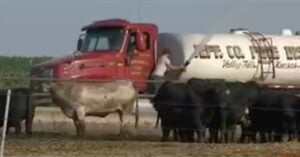Last week, high humidity and low wind speeds on Kansas feedlots left some cattle fighting to stay alive, including near Muscotah. Amid death losses and record heat, fire departments in the area stepped in to help provide life-saving water to cool cattle off.
Although the number of cattle lost has not been publicly disclosed yet, a source told AGDAILY that the death totals are around 2,000 head.
The Kansas Livestock Association noted to KCTV5 that even just a couple hundred deaths mean a loss of hundreds of thousands of dollars for feedlots.
“At night, we are not getting below 70 degrees. Most of the time, we haven’t gotten below 75,” said Scarlett Madinger of the Kansas Livestock Association. “Cattle need it to get below 70 if they are going to dispense of the heat they have collected throughout the day.”
Heat indexes in the area were reported to be over 130 degrees. From Aug. 19 to Aug. 24 the average high temperatures in Topeka reached 103.4 degrees, and it was 107.4 degrees in Concordia. Topeka, in particular, experienced 10 consecutive days with over 100-degree weather, according to the National Oceanic and Atmospheric Administration.
Heat cattle can’t disperse builds day after day, creating a challenging environment for livestock and the people caring for them. One feedlot owner and operations officer, Shawn Tiffany, told KSNT that cattle on their feedlots in McPherson, Morris, and Lyon counties fared surprisingly well and that the cattle lost already had a history of respiratory issues.
The community has rallied around the feedlots, helping cool off cattle where possible. During the heat wave, volunteer firefighters brought hundreds of thousands of gallons of water to feedlots to help spray down the livestock, keeping them cooler.

Cattle weren’t the only animals affected by the heat — a semi-truck broke down in Interstate 70 full of 250 hogs during the heat wave as well. 13WIBW reports that firefighters in Geary County were quick to stop and spray the pigs down, with assistance from Riley County Fire Department.
Last year, thousands of cattle died during a heatwave in southwest Kansas. While the heat waves and losses are unprecedented, cattle producers do everything they can to help cattle deal with upcoming high heat indexes in the forecast.
During heat events, extra, clean water, air movement, bedding, shade, and spreading cattle out can help prevent overheating.
»Related: The common sense answer to cattle losses in Kansas


